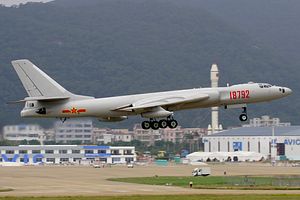Last Friday, FOX News reported from Defense Department sources that China flew a bomber capable of carrying nuclear weapons along its nine-dash line in the South China Sea as a response to U.S. President-elect Trump’s call with the president of Taiwan a week earlier. The claim was repeated across major media outlets, presenting the flight as a show of force to send a message to the incoming president, and a harbinger of heightened tensions to come between the United States and China.
But presentation to the contrary, the flight is likely much less significant. The reported aircraft, an H-6K bomber, is almost certainly not nuclear-capable. And while the flight might be intended as a signal, it needs to be viewed in the context of increasing Chinese air force patrols in the region generally, and not exclusively in response to the Taiwan call. The greater danger may not be China’s signal to President-elect Trump but the U.S. reading more into the signal than China intended.
A Nuclear Signal That Wasn’t
Nearly every news outlet that picked up the story repeated the “nuclear capable” claim. However, Dr. Jeffrey Lewis, an arms control and nuclear weapons expert at the Middlebury Institute of International Studies, vigorously rejected that claim. He explained that only a single H-6 was ever converted to drop nuclear weapons, but for tests and not for operational use, and that even the U.S. Department of Defense’s most recent report on China’s military activities refers only to a future intent to build a nuclear-capable bomber, and no current or imminent capability.
This distinction has critical implications on how to interpret the message China was sending with the patrol. While not speaking officially for the Chinese government, Senior Captain Liang Fang of China’s National Defense University claimed that it was meant to communicate three things: that China maintains its sovereignty and jurisdictional claims within the nine-dash line; that China was unafraid of threats in the South and East China Seas and capable of winning military clashes there; that President-elect Trump should not play with fire over Taiwan and, likewise, neither should the president of Taiwan. Dr. Lewis worries that repeating the claim that the bomber was nuclear-capable risks the U.S. interpreting China as communicating that these issues were nuclear conflict thresholds when it was really sending a conventional message, not a nuclear one.
Not a Unique Provocation, Part of a Pattern
While this patrol may in fact have been timed to respond to the president-elect’s Taiwan call, it was not a new message, nor an escalated one. China flew bombers around the nine-dash line in 2015, so while this was not a routine flight path, it was not unprecedented. It also comes on the heels of repeated patrols in the South China Sea by the Chinese air force since the July The Hague ruling that invalidated the basis for many of China’s nine-dash line claims.
Following those first flights in July, a Chinese military spokesman said that the Chinese air force will conduct combat patrols in the South China Sea on a regular basis. Additional patrols in August were conducted to “normalize” Chinese military presence in the skies over the South China Sea. China has also conducted massive air force exercises and patrols in sensitive skies near Japanese territory this fall, causing the Japanese Air Self-Defense Force to scramble its jets more than 400 times in the past six months, almost twice the rate as last year.
The volume of this Chinese Air Force activity is itself a cause for concern, and also something that should be considered in concert with China’s naval activity, missile advances, and island building. But by establishing regularity in that activity, China should be viewed as trying to prevent other players in the region from interpreting any single event as a unique threat or deviation from expected behavior and thereby unintentionally precipitating a crisis.
The Threat of Mutual Threat Inflation
It is also dangerous to give the impression that China is unique in conducting such “bomber diplomacy.” The United States flew two unarmed B-52 bombers, which are nuclear-capable, through the East China Sea in 2013 to protest China’s declaration of an Air Defense Identification Zone (ADIZ) there. The U.S. intended to communicate simply that it would not recognize China’s unilateral ADIZ, but not that it was a nuclear-threshold issue, while Chinese analysts called the flight a “clear provocation.” This mirrored response should warn the U.S. against expecting China to interpret U.S. signals and operations with greater circumspection than it is willing to show itself.
Still, while exaggerating news like this bomber flight without providing broader context does a disservice to the public discourse, this should not be conflated with internal policy deliberation. Dr. Lewis’ concerns about over-interpreting the threat implicit in this bomber flight apply mostly to media reporting. Classified government assessments and briefs to leaders would presumably not repeat the “nuclear-capable” error, or would at least include additional non-public context, as well as the broader pattern of Chinese Air Force patrols in the South and East China Seas.
Reports that President-elect Trump intends to forego regular intelligence briefings and may be skeptical of the intelligence community generally does raise the specter that context for his policy decisions may end up coming from media rather than finished intelligence assessments. But until his post-inaugural routine is established that concern is speculative, and his senior advisors in the State and Defense Departments have those reports before policies are finalized and executed. Still, given the early unknowns inherent to relations under a new administration, the sensationalizing of this event should caution both China and the United States against assuming the diplomatic or military signals they send are received as intended.

































